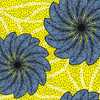
Ankara Styles
Ankara fabric, also known as African wax print, originated from Dutch wax prints intended for the Indonesian market in the 19th century. When these prints failed to gain popularity in Indonesia, they found a receptive audience in West Africa, where their vibrant patterns and colours resonated with local tastes. Over time, Ankara became deeply integrated into African culture, especially in Nigeria, where it evolved from an import to a symbol of national identity.
Cultural significance
In Nigeria, Ankara is more than just a fabric; it's a medium of expression. The fabric is often used in "aso ebi," a tradition where families and friends wear matching outfits during special occasions like weddings and festivals, symbolising unity and solidarity. Each Ankara pattern often carries specific meanings or tells a story, reflecting proverbs, historical events, or societal values.
Modern adaptations
Ankara's versatility has led to its adoption in various forms beyond traditional attire. Contemporary designers incorporate it into modern fashion pieces such as suits, dresses, and accessories. Artists also use Ankara in visual arts, creating collages and mixed-media works that celebrate African heritage. The fabric's adaptability has made it a staple in both everyday wear and high fashion.
Economic impact
The Ankara industry contributes significantly to local economies across Africa. From textile production to fashion design and retail, it provides employment opportunities and supports small businesses. The global demand for Ankara has also opened international markets for African designers, promoting cultural exchange and economic growth.
Global recognition
Ankara has gained international acclaim, with global fashion icons and celebrities embracing the fabric. Designers like Stella McCartney and Lisa Folawiyo have featured Ankara in their collections, showcasing its appeal on runways worldwide. This global exposure has elevated Ankara from a regional textile to a symbol of African creativity and resilience.
















